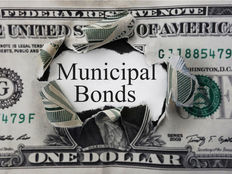
2019 will go down as one of the best years for fixed-income investors. Long-duration government bonds, investment-grade corporate bonds, and municipal bonds have all outperformed.
For fixed-income investors, the past 12 months have delivered outsized returns, as demand for safe-haven assets continued to surge. Year-to-date through November, long-duration U.S. Treasuries were up almost 19%, investment-grade corporate bonds gained more than 14%, and municipal bonds were up by about 7.2%.
Use our Screener to find the right municipal bonds for your portfolio.
Municipal Debt Performance Year-to-Date in 2019
Municipal bond funds have seen positive net flows for 47 weeks straight, including a record-setting $2.4 billion in the final week of November. Investors have added a whopping $82.7 billion to muni funds this year, crushing the previous record of $81 billion in 2009. All said, the S&P Municipal Bond Index saw average monthly returns of 0.17% in 2019, which translated into a year-to-date gain of 6.91%.
Municipal bonds with long maturities (20 years or more) returned an average 0.22% per month, which translated into a year-to-date gain of 9.77%. Intermediate maturities (3-14 years) rose 6.53% in 2019. The high-yield category gained 10.14% this year. Municipal bond markets in California, New Jersey, New York, and Pennsylvania also rallied between 6.66% and 7.75% on a year-to-date basis in 2019, according to BlackRock.
Although returns of this magnitude are rarely repeated, 2020 is shaping up to be another year of opportunity for fixed-income investors. Many of the same themes that emerged in 2019 will continue over the next 12 months. Chief among them include the Federal Reserve’s dovish pivot on interest rates and the strong relative performance of municipals compared to Treasuries. According to Nuveen, performance continues to favor the intermediate and long portions of the yield curve.
The U.S. Treasury yield curve offered a lot of surprises in 2019 after a frightful inversion between long-term and short-term yields signaled that recession may be on the horizon. An inverted yield curve predicts recession with pinpoint accuracy, with the last five inversions signaling a downturn an average of 22 months later. The yield curve has corrected, though long-term interest rates remain well below year-ago levels.
Want to learn how to interpret Credit Ratings for municipal bonds? Click here.
Why Municipals Have Outperformed
The municipal bond market is coming off a strong year thanks to a combination of tax reform, rising state revenues, declining default rates and improving credit quality. Supply was equally robust, with $44.7 billion worth of municipal bonds issued in November alone. That’s a 54% year-over-year increase. Since August, muni issuers have issued $41.2 billion worth of taxable bonds compared to just $16.6 billion through the first seven months of 2019. According to RBC Wealth Management, municipalities were on track to issue more than $450 billion worth of bonds this year
As Nuveen reports, a $10,000 cap on State and Local Tax (SALT) deductions could increase the tax burden for certain individuals. Because SALT doesn’t impact state and local government revenue, tax reforms appear to have boosted demand for municipal bonds.
State revenues increased sharply throughout the year despite concerns of a slowing economic recovery. Combined state and local revenues jumped 11.1% annually in the second quarter, according to the Urban Institute. During the same quarter, state revenues were up 12.9% year-over-year.
Municipals are also attractive because payment defaults continue to run at low levels. With the exception of Puerto Rico, which saw several defaults in 2016 and 2017, the payment default rate for municipal bonds remains very low. What’s more, we know that default rates are highest in certain segments of the bond market, including nursing homes, industrial development and multifamily housing bonds.
Data from Moody’s also show that credit ratings for municipal bonds have improved in recent years. In all of 2018, Moody’s issued credit upgrades to 480 All Public Finance bonds compared with 392 downgrades. There were 287 upgrades for Tax & Appropriation bonds compared with 249 downgrades. On the revenue side, 193 bonds saw improved credit ratings compared with 143 that saw downgrades.
Be sure to check our Education section to learn more about municipal bonds.
The municipal bond market is not without its challenges, but with interest rates anchored near record levels, the environment should be favorable for issuers. Since August, muni issuers have taken advantage of the current low-interest rate environment, having issued $41.2 billion of taxable bonds, compared to $16.6 billion through the first seven months of 2019.
The Federal Reserve has slashed interest rates three times since July and has signaled it will remain on hold for the foreseeable future. Against this backdrop, there’s no reason to believe interest rates are going higher anytime soon.
The Bottom Line
2019 was a stellar year for municipal bonds. Conditions are favorable for a continuation of that trend in 2020.
Sign up for our free newsletter to get the latest news on municipal bonds delivered to your inbox.






